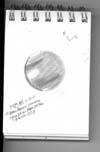
Mars closest approach is on December 19, and opposition is on December 24th. This year Mars is not as close as in 2003 or 2005 but we see it higher in the sky - which is good for Earthbound viewers - high means better views. In November 2007 begins the retrograde loop that will last to the end of January 2008 and will bring Mars to apparently swirl as it appears to overtake us. This is interesting to me, and I hope you find it interesting too. Thanks to Akkana Peck for the article.
2007 offers the most favorable period for telescopic viewing of Mars for many years. During the 2007 apparition, Mars will not be as close to Earth as it was in the last apparition in 2005. But for observers in the Northern Hemisphere Mars will be higher in our sky - nearly overhead, so every astronomy enthusiast will have the opportunity to see and enjoy Mars. So ladies and gentleman, rev up your observing instruments. Red planet viewing is in full swing!
Telescope size isn't everything when it comes to observing Mars. Atmospheric turbulence is one of the two even more important factors for observers. An object must be at least 30 degrees above the horizon for moderately steady seeing. Overhead is 90 degrees above the horizon, so most amateur astronomers will always wait until Mars is halfway between horizon and overhead for a serious look, image or sketch of Mars. You should too. The second important factor that affects observing is the atmospheric turbulence....on Mars! We have seen some dust clouds in 2007 earlier in the year, in fact they are fascinating to observe!
Thanks to Geoff Gaherty of Toronto's RASC, and to the RASC Observers Handbook 2007 for this information about Mars 2007. This is a book worth having. I have one at home and another at work!

| November 11, 2007 - Magnitude -0.84, 13.2" diameter, Central Meridian (CM) 72° at 11:15 UT. Distance from Earth: 0.70 AU, 106 million km, 66 million miles. |
White Oaks.home | Sketches Index | 2005 sketches | 2003 sketches | Previous | Next